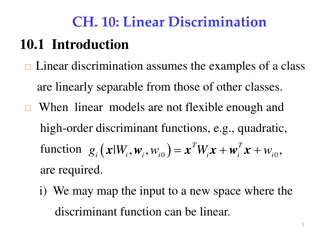
PageRank Algorithm: Understanding Node Ranking and Probability Computation
"Explore the PageRank algorithm used by Google to rank webpages, understand different ways to compute probabilities, simulate random processes, and implement adjacency matrix concepts. Dive into the Random Surfer Model and learn about node ranking based on traversal probabilities in a graph."
Download Presentation

Please find below an Image/Link to download the presentation.
The content on the website is provided AS IS for your information and personal use only. It may not be sold, licensed, or shared on other websites without obtaining consent from the author. If you encounter any issues during the download, it is possible that the publisher has removed the file from their server.
You are allowed to download the files provided on this website for personal or commercial use, subject to the condition that they are used lawfully. All files are the property of their respective owners.
The content on the website is provided AS IS for your information and personal use only. It may not be sold, licensed, or shared on other websites without obtaining consent from the author.
E N D
Presentation Transcript
Linear Linear programming programming Example Numpy: PageRank scipy.optimize.linprog Example linear programming: Maximum flow
PageRank PageRank
PageRank PageRank - - A A NumPy NumPy / / Jupyter Jupyter / / matplotlib matplotlib example example Google's original search engine ranked webpages using PageRank View the internet as a graph where nodes correspond to webpages and directed edges to links from one webpage to another webpage Google s PageRank algorithm was described in (ilpubs.stanford.edu:8090/361/, 1998)
Five Five different different ways PageRank PageRank probabilities ways to probabilities to compute compute 1) Simulate random process manually by rolling dices 2) Simulate random process in Python 3) Computing probabilities using matrix multiplication 4) Repeated matrix squaring 5) Eigenvector for = 1
Random Randomsurfer model ( surfer model (simplified simplified) ) The PageRank of a node (web page) is the fraction of the time one visits a node by performing an infinite random traversal of the graph starting at node 1, and in each step with probability 1/6 jumps to a random page (probability 1/6 for each node) with probability 5/6 follows an outgoing edge to an adjacent node (selected uniformly) The above can be simulated by using a dice: Roll a dice. If it shows 6, jump to a random page by rolling the dice again to figure out which node to jump to. If the dice shows 1-5, follow an outgoing edge - if two outgoing edges roll the dice again and go to the lower number neighbor if it is odd.
Adjacency Adjacency matrix and matrix and degree degree vector vector pagerank.ipynb import numpy as np # Adjacency matrix of the directed graph in the figure # (note that the rows/colums are 0-indexed, whereas in the figure the nodes are 1-indexed) G = np.array([[0, 1, 0, 0, 0, 0], [0, 0, 0, 1, 0, 0], [1, 1, 0, 0, 0, 0], [0, 1, 0, 0, 1, 0], [0, 1, 0, 0, 0, 1], [0, 1, 0, 0, 0, 0]]) n = G.shape[0] # number of rows in G degree = np.sum(G, axis=1, keepdims=True) # column vector with row sums = out-degrees # The below code handles sinks, i.e. nodes with outdegree zero (no effect on the graph above) G = G + (degree == 0) degree = np.sum(G, axis=1, keepdims=True) # add edges from sinks to all nodes (uses broadcasting)
Simulate random walk (random surfer model) Simulate random walk (random surfer model) pagerank.ipynb from random import randint, choice STEPS = 1000000 # adjacency_list[i] is a list of all j where (i, j) is an edge of the graph. adjacency_list = [[j for j, e in enumerate(row) if e] for row in G] count = np.zeros(n) # histogram over number of node visits state = 0 # start at node with index 0 for _ in range(STEPS): count[state] += 1 # increment count for state if randint(1, 6) == 6: # original paper uses 15% instead of 1/6 state = randint(0, 5) else: state = choice(adjacency_list[state]) print(adjacency_list, count / STEPS, sep='\n') Python shell | [[1], [3], [0, 1], [1, 4], [1, 5], [1]] [0.039365 0.353211 0.02751 0.322593 0.1623 0.095021]
Simulate random walk (random surfer model) Simulate random walk (random surfer model) pagerank.ipynb import matplotlib.pyplot as plt plt.bar(range(6), count) plt.title('Random Walk') plt.xlabel('node') plt.ylabel('number of visits') plt.show()
Transition matrix Transition matrix A A pagerank.ipynb A = G / degree # Normalize row sums to one. Note that 'degree' # is an n x 1 matrix, whereas G is an n x n matrix. # The elementwise division is repeated for each column of G print(A) Python shell | [[0. 1. 0. 0. 0. 0. ] [0. 0. 0. 1. 0. 0. ] [0.5 0.5 0. 0. 0. 0. ] [0. 0.5 0. 0. 0.5 0. ] [0. 0.5 0. 0. 0. 0.5] [0. 1. 0. 0. 0. 0. ]]
Repeated Repeated matrix matrix multiplication multiplication pagerank.ipynb We now want to compute the probability p(i)jto be in vertex j after i steps. Let p(i)= (p(i)0, , p(i)n 1). Initially we have p(0) = (1, 0, , 0). ITERATIONS = 20 p_0 = np.zeros((n, 1)) p_0[0, 0] = 1.0 M = 1 / (6 * n) + 5 / 6 * A.T p = p_0 prob = p # 'prob' will contain each # computed 'p' as a new column for _ in range(ITERATIONS): p = M @ p prob = np.append(prob, p, axis=1) print(p) We compute a matrix M, such that p(i)= Mi p(0) (assuming p(0) is a column vector). If we let 1ndenote the n n matrix with 1 in each entry, then M can be computed as: (i+1)=1 6 1 n+5 (i) Ak,j 6 pj pk Python shell | [[0.03935185] [0.35326184] [0.02777778] [0.32230071] [0.16198059] [0.09532722]] k 1 6 1 n1n+5 p(i+1) = 6AT p(i) M
Rate of Rate of convergence convergence pagerank.ipynb x = range(ITERATIONS + 1) for node in range(n): plt.plot(x, prob[node], label=f'node {node}') plt.xticks(x) plt.title('Random Surfer Probabilities') plt.xlabel('Iterations') plt.ylabel('Probability') plt.legend() plt.show()
Repeated squaring Repeated squaring M ( (M (M p(0))) ) = Mk p(0) = M2log2 k p(0) = ( ((M2)2)2 )2 p(0) log2k k multiplications, k power of 2 pagerank.ipynb from math import log2 MP = M for _ in range(1 + int(log2(ITERATIONS))): MP = MP @ MP p = MP @ p_0 print(p) Python shell | [[0.03935185] [0.35332637] [0.02777778] [0.32221711] [0.16203446] [0.09529243]]
PageRank : Computing eigenvector PageRank : Computing eigenvector for for = 1 = 1 We want to find a vector p, with |p| = 1, where Mp = p, i.e. an eigenvector p for the eigenvalue = 1 pagerank.ipynb eigenvalues, eigenvectors = np.linalg.eig(M) idx = eigenvalues.argmax() # find the largest eigenvalue (= 1) p = np.real(eigenvectors[:, idx]) # .real returns the real part of complex numbers p /= p.sum() # normalize p to have sum 1 print(p) Python shell | [0.03935185 0.3533267 0.02777778 0.32221669 0.16203473 0.09529225]
PageRank : Note on practicality PageRank : Note on practicality In practice an explicit matrix for billions of nodes is infeasible, since the number of entries would be order of 1018 Instead use sparse matrices (in Python modul scipy.sparse) and stay with repeated multiplication
Linear Linear programming programming
scipy.optimize.linprog scipy.optimize.linprog scipy.optimize.linprog can solve linear programs of the following form, where one wants to find an n x 1 vector x satisfying: Minimize: cT x dimension c : n x 1 Subject to: Aub x bub Aub: m x n Aeq: k x n bub: m x 1 beq: k x 1 Aeq x = beq Some other open-source optimization libraries PuLP and Pyomo For industrial strength linear solvers, use solvers like Cplex or Gurobi
Linear Linear programming programming example example linear_programming.py Maximize 3 x1+ 2 x2 Subject to 2 x1+ 1 x2 10 5 x1+ 6 x2 4 -3 x1+ 7 x2 = 8 import numpy as np from scipy.optimize import linprog c = np.array([3, 2]) A_ub = np.array([[ 2, 1], [-5, -6]]) # multiplied by -1 b_ub = np.array([10, -4]) A_eq = np.array([[-3, 7]]) b_eq = np.array([8]) res = linprog(-c, # maximize = minimize the negated A_ub=A_ub, b_ub=b_ub, A_eq=A_eq, b_eq=b_eq) print(res) # res.x is the optimal vector Minimize - (3 x1+ 2 x2) Subject to 2 x1+ 1 x2 10 -5 x1 + -6 x2 -4 -3 x1+ 7 x2 = 8 Python shell | fun: -16.35294117647059 message: 'Optimization terminated successfully. nit: 3 slack: array([ 0. , 30.47058824]) status: 0 success: True x: array([3.64705882, 2.70588235])
Maxmium Maxmium flow flow
Solving maximum flow using linear programming Solving maximum flow using linear programming Maximize x7 + x8 Subject to x0 4 x1 3 x2 1 x3 1 x4 3 x5 1 x6 3 x7 1 x8 5 x1= x4 + x5 x0= x2 + x3 x3+ x5 + x6 = x8 x2+ x4 = x6 + x7 flow value = 1 x5 1 = 2 B D x8 = 4 3 x4 5 x1 = 3 3 constraints A F capacity x6 = 2 3 1 1 x0 = 2 x3 = 1 sink source x7 = 1 4 1 C E x2 = 1 conservation flow We will use the scipy.optimize.linprog function to solve the maximum flow problem on the above directed graph. We want to send as much flow from node A to node F. Edges are numbered 0..8 and each edge has a maximum capacity. Note: solution not unique
Solving maximum flow using linear programming Solving maximum flow using linear programming Minimize - x7 - x8 Subject to x0 4 x1 3 x2 1 x3 1 x4 3 x5 1 x6 3 x7 1 x8 5 0= - x1 + x4 + x5 0 = - x0 + x2 + x3 0 = - x3- x5 - x6 +x8 0= - x2 -x4 + x6 + x7 x is a vector describing the flow along each edge c is a vector to add the flow along the edges (7 and 8) to the sink (F), i.e. a function computing the flow value Auband bubis a set of capacity constraints, for each edge flow capacity Aeqand beqis a set of flow conservation constraints, for each non-source and non-sink node (B, C, D, E), requiring that the flow into equals the flow out of a node flow value cT x constraints Aub x bub capacity I x capacity Aeq x = beq= 0 conservation flow
maximum-flow.py import numpy as np from scipy.optimize import linprog # 0 1 2 3 4 5 6 7 8 conservation = np.array([[ 0,-1, 0, 0, 1, 1, 0, 0, 0], # B [-1, 0, 1, 1, 0, 0, 0, 0, 0], # C [ 0, 0, 0,-1, 0,-1,-1, 0, 1], # D [ 0, 0,-1, 0,-1, 0, 1, 1, 0]]) # E # 0 1 2 3 4 5 6 7 8 sinks = np.array([0, 0, 0, 0, 0, 0, 0, 1, 1]) # 0 1 2 3 4 5 6 7 8 capacity = np.array([4, 3, 1, 1, 3, 1, 3, 1, 5]) res = linprog(-sinks, A_eq=conservation, b_eq=np.zeros(conservation.shape[0]), A_ub=np.eye(capacity.size), b_ub=capacity) Python shell | message: 'Optimization terminated successfully.' nit: 9 slack: array([2., 0., 0., 0., 1., 0., 1., 0., 1.]) status: 0 success: True x: array([2., 3., 1., 1., 2., 1., 2., 1., 4.]) fun: -5.0 print(res) the solution found varies with the scipy version






















